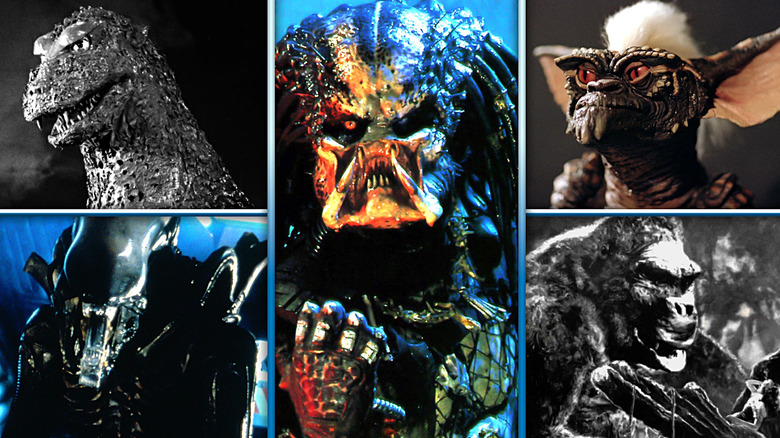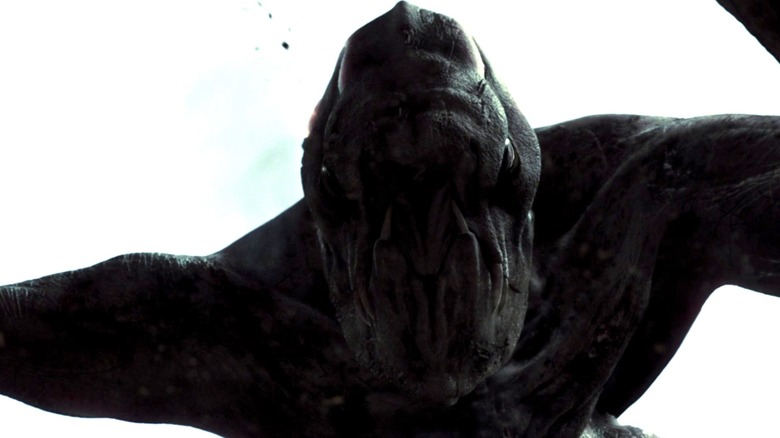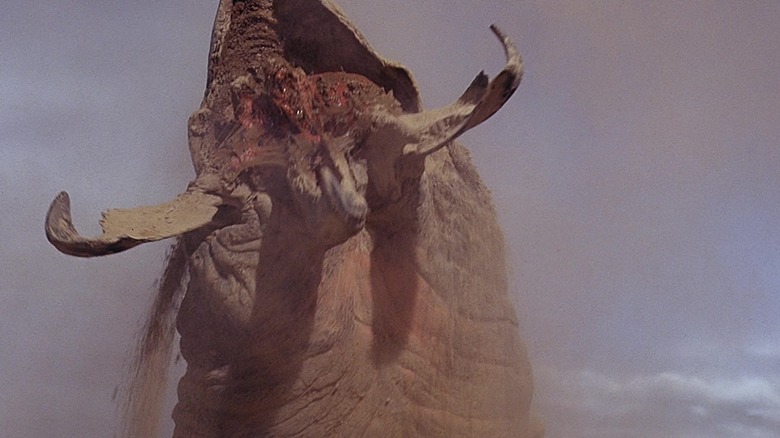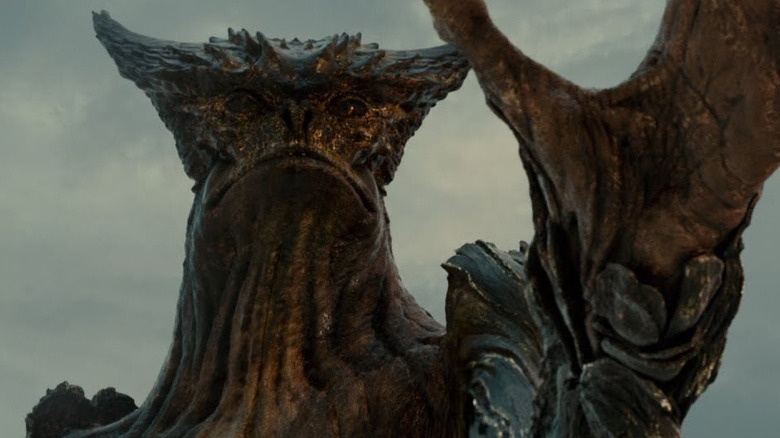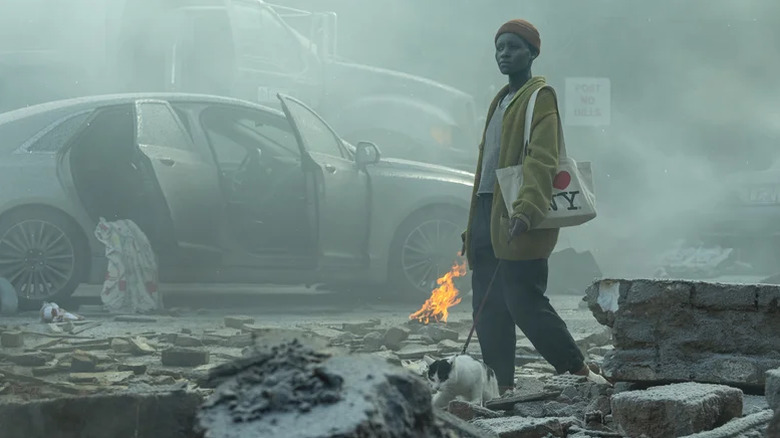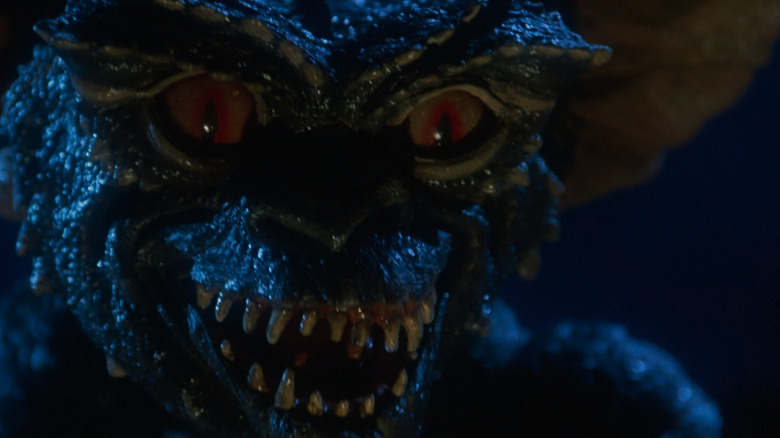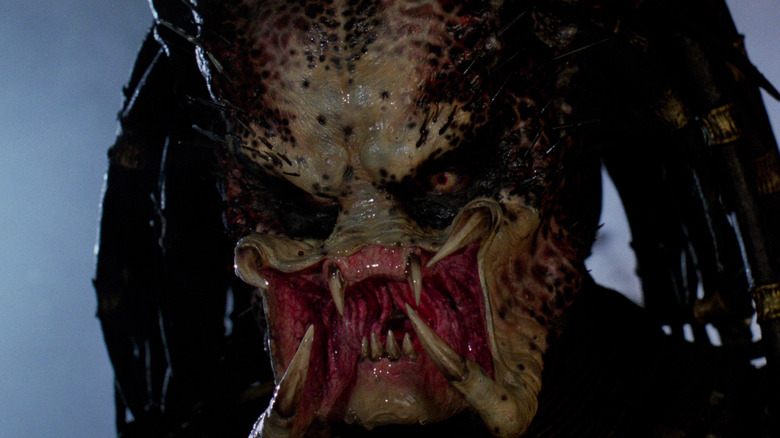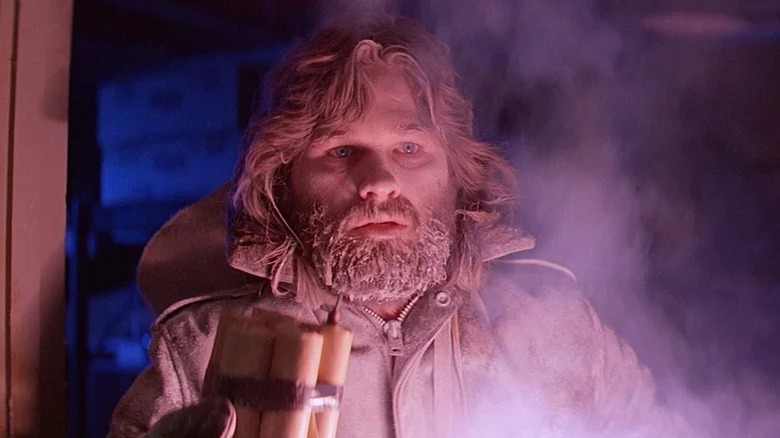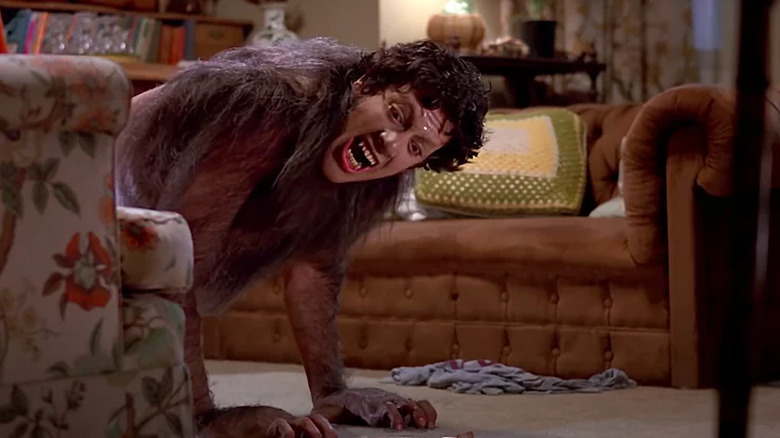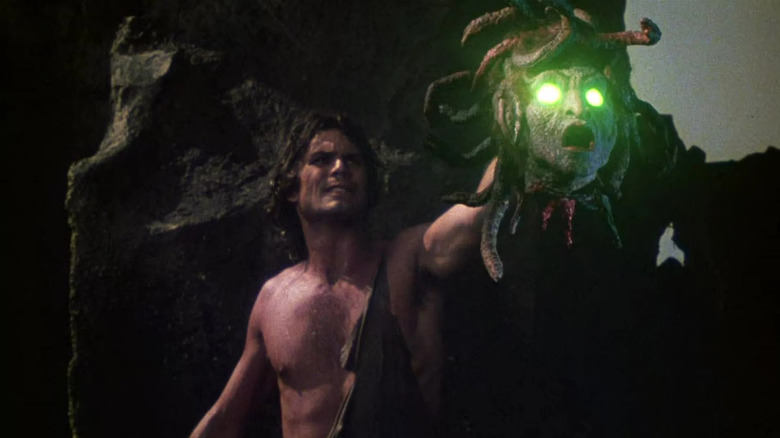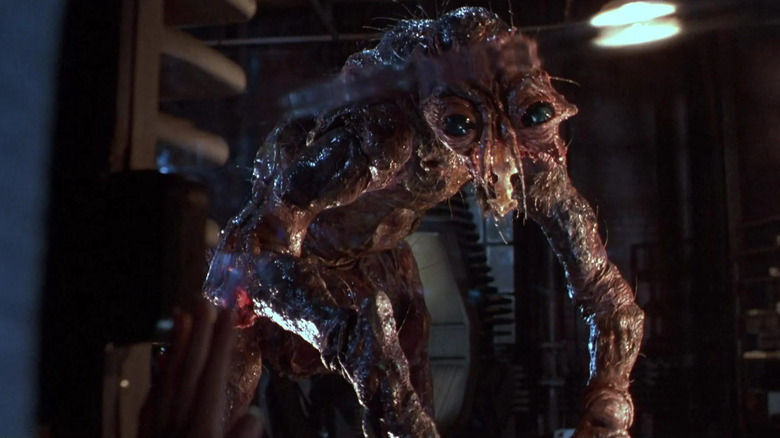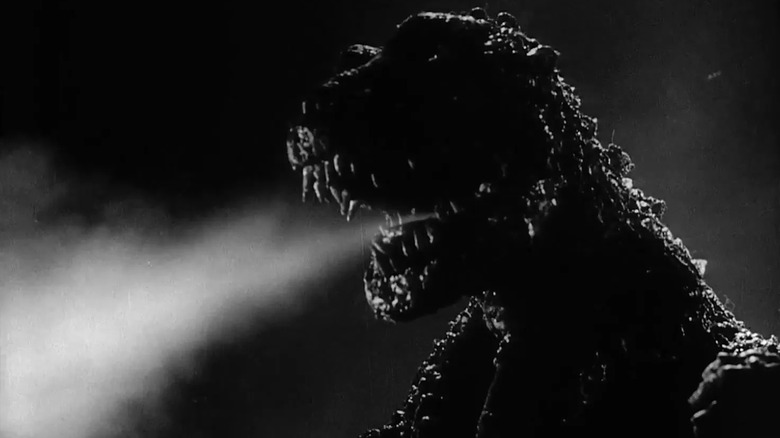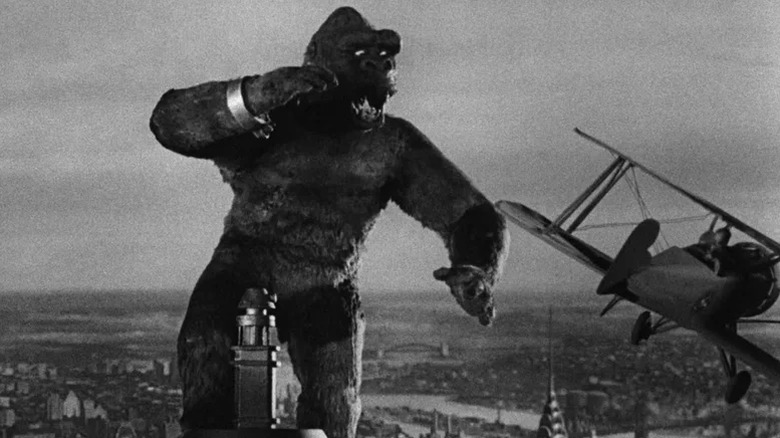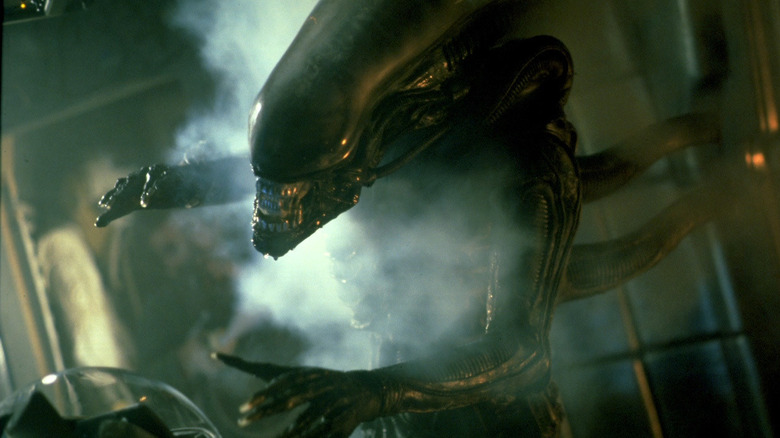The 15 Best Monster Movies Of All Time, Ranked
Ever since we first learn about dinosaurs as kids, the idea of monsters is fascinating. More powerful and fantastical than regular animals, they inhabit the closet space of our minds and dark corners of imagination. It's a bummer to grow up and realize that creatures like Bigfoot and Nessie probably don't exist, but it's a blast to see movies in which the only limits to the large, dangerous things we can see are the filmmakers' creativity.
"Monster" has many definitions, but for the purposes of this list, they are creatures that do not and have not existed in real life (so far as we know), with a feral or savage side (this rules out sharks and, yes, dinosaurs). Horror villains that are basically intelligent, leveled-up humans don't count (think Count Dracula, Freddy Krueger, or Pinhead), but devolved humans like werewolves are fair game. Normal human beings who simply look or act frightening belong on a list of villains instead. Ironically, this rules out most of the Universal "monsters," but it keeps the included movies in line with the scary, fantastical beasts that the word usually evokes.
With all that out of the way, let's dig into the best monster movies of all time.
15. Cloverfield
After the success and immense profitability of "The Blair Witch Project" and "Paranormal Activity," found footage became a popular format for low-budget filmmakers to pull off horror movies with unknown actors. "Cloverfield" took that style and went in the opposite direction, imagining a grand-scale giant monster attack from the point of view of the folks at ground level filming it. To keep things interesting during moments when the characters evaded the massive beast, they also had to escape the smaller parasites it scratched off its body after emerging. It's a tactic that, for once, makes you root for the city not to be smashed.
A secretive ad campaign and a mostly hidden mythology that fans had to dig for online enhanced the mystery and backstory of "Clover," the creature whose origin is only vaguely hinted at onscreen. Producer J.J. Abrams wanted to create a distinctly American kaiju, but one which, unlike King Kong and Godzilla, would never be considered adorable and remain intense and scary. Instead of building on the "Cloverfield" story, however, the franchise spawned two mostly unrelated spin-off movies, "10 Cloverfield Lane" and "The Cloverfield Paradox."
14. The Little Shop of Horrors (1960)
Its script was conceived after a late night of drunken spitballing, and its interiors shot in two days when producer-director Roger Corman learned he had time to reuse his sets for "A Bucket of Blood," if he acted quickly. What ensued gave us possibly the most famous man-eating plant in cinema history, originally named Audrey Junior.
It's the simple story of a plant-store employee named Seymour (Jonathan Haze) who turns his fortunes around when he discovers a strange, exotic plant that feeds on human blood...and later, full bodies. A wacky sense of dark humor, and strong early performances by the likes of Dick Miller and Jack Nicholson in supporting roles made the cinematic quickie an unexpected cult hit, which still holds up.
Most moviegoers are more familiar with the musical remake based on the stage adaptation, in which the plant, renamed Audrey II, not only talks but sings. It's less dark than the original (though it did almost have a darker ending), but by having Audrey II still re-bloom, it affirms the popularity of the giant carnivorous vegetable.
13. Tremors
Before the culture wars had to permeate every fandom, there was something a lot more appealing about deadly mutant underground worms terrorizing a desert town and meeting their match in redneck survivalists. Today, we might be more surprised by everyone working together to fight a common threat in this situation, but look to Michael Gross as an example of thespian bipartisanship: He played both hippie dad Stephen Keaton on "Family Ties" and gun nut Burt Gummer in "Tremors," the latter being the only character to continue through all the sequels.
The Graboid monsters are simple and effective, amplifying the old childhood game of "The Floor Is Lava" to lethal reality, except that instead of lava, it's sand, and this is the desert, and there are giant killer worms underneath you. However, this isn't "Dune," and you can't coexist with them, nor would anybody want to. Best to just enjoy them eating people from a distance.
12. Kong: Skull Island
Godzilla movies defined the kaiju subgenre, in which giant monsters stomp through cities, and each other, and for the most part, they're beloved by kids. Adults, though, may have trouble suspending disbelief, given how often it's clear that these are just men in bulky costumes walking over model kits and dolls. In the modern age of CG, we can fix that, but it has taken a while. Roland Emmerich's 1998 "Godzilla," beloved by only its director, crawled so that Gareth Edwards' 2014 "Godzilla" could properly stomp. It took Jordan Vogt-Roberts' "Kong: Skull Island," however, to make a modern, photo-real kaiju movie really kick ass.
As in 1933, a giant ape named Kong is discovered on a hidden, skull-shaped island, but the similarities mostly end there. This Kong is as tall as a building, and in fights with aircraft, he wins. He does face worthy opponents, however, in the massive skullcrawler monsters that emerge from the Hollow Earth to attack him and the tribe of humans he protects.
Kong has taken on Godzilla twice after that, but none of the environments have had quite the gleefully nasty surprises of Skull Island.
11. Colossal
Spanish filmmaker Nacho Vigalondo can usually be trusted to have off-kilter takes on genre filmmaking, from time travel ("Timecrimes") to aliens ("Extraterrestrial"). His greatest subversion, however, is of the kaiju variety in "Colossal."
Getting blackout drunk every night, Anne Hathaway's Gloria soon realizes that, while she's wasted, a giant monster appears in Seoul, South Korea and trashes the city. Somehow it is created by her walking through a local playground, and if she's careful, she can control the creature half a world away. Soon afterward, her passive-aggressive childhood friend turned would-be suitor Oscar (Jason Sudeikis) tries to imitate her behavior and finds himself materializing a giant robot, also in Seoul.
There's a solid metaphor in there about destructive alcoholic behavior and hanging on to childish ways of dealing with problems, but it's not just in their heads — these kaiju are real, the fantasy rules are consistent, and the ultimate resolution is ingenious.
10. A Quiet Place: Day One
The so-called Death Angels from the "Quiet Place" franchise have such a distinctive look that it's a wonder they haven't been licensed for more merchandise. Officially inspired by mummified human cadavers, and perhaps unofficially by the lickers in the "Resident Evil" games, they're terrifying in size, speed, and the ability to hone in on any sound. That's not to even mention their pop-open cauliflower heads.
So why do we rank the third film in the franchise as the best? Simply put, it's the story we wanted to see these creatures in from the beginning during their initial invasion of the planet. We've had two movies to learn what to expect, which adds an extra sense of doom — how can anyone survive this when we know how deadly the monsters are, and that the story has to end with the collapse of civilization as we know it? The answer is: very, very carefully.
It's also a lot less irritating than the first film, in which the main couple actively decides to have a new baby in a world where you can't make any noise. What did they think would happen?
9. Gremlins
Like a lot of Joe Dante movies, "Gremlins" compulsively reminds the viewer, via TV sets, posters, and even projected movies exactly what the director's influences are. As tiring as that can be, the creatures at the center of this tale are charming, scary, and even partially cute; as such, they have endured, and "Gremlins" remains a Christmas movie of choice for those with dark senses of humor.
An adorable furry creature called a mogwai, given the name of Gizmo and voiced by Howie Mandel, is intelligent, helpful, and can sing sweet songs. Unfortunately, if it gets wet, it reproduces, creating far less moral offspring; if they eat food after midnight, they metamorphosize into reptilians with sharp teeth and claws. These gremlins will happily break everything, kill for fun, and laugh about it.
Dante deftly balances gross, scary, and funny moments to make this an '80s classic just barely appropriate for brave kids.
8. Predator
Predators, or Yautja, as the hunters from another world are canonically known but never called onscreen, are generally more advanced than humans, with the ability to fly spaceships, build nuclear bombs, and possibly even travel through time. However, they do have a savage, feral side to them when they really get involved in a hunt. Remarkably inconsistent in their standards of what constitutes a fair fight, they've been known to bare-knuckle it, but they're also quite often cheats and sore losers.
The original 1987 film "Predator" starts out as a "Rambo"-style men on a mission movie with Arnold Schwarzenegger, Jesse Ventura, and Carl Weathers leading a team of macho, meat-headed, movie-muscular warriors to blow some stuff up. Before long, though, they become the prey of a near-invisible creature with deadly hi-teach weaponry. Most of them don't have a chance, until the Predator makes the mistake of going one-on-one with Arnold.
Stan Winston's creature design, with reptilian dreadlocks and vagina-dentata mandibles, has stuck in the popular consciousness ever since. The "Predator" creature continues to appear in movies, and it's a testament to the popularity of the monster that none of its surviving human adversaries has ever returned for a sequel... and nobody minds.
7. The Thing (1982)
The second movie adaptation of the 1938 John W. Campbell Jr. novella "Who Goes There?" reimagines its shape-shifting alien life form in ways that wouldn't even have been considered in the '30s. The monster in John Carpenter's version can shape shift to look and sound like any living creature, but in the in-between stages, it's a horrific mass of teeth, tentacles, and flayed flesh. All it wants to do is propagate, and even though it can take human form and speak English, it has no interest in communication with other lifeforms — only in camouflaging itself long enough to absorb the next person.
"The Thing" is one of three notable collaborations between Carpenter and Kurt Russell, along with "Escape From New York" and "Big Trouble in Little China," and it's the only one of the triptych in which a monster upstages the star in literally every scene in which it's discovered and has to briefly reveal itself. By the end of the movie, Russell's R.J. has either defeated the creature at the cost of his own life, or is about to meet his doom at the hands of a possibly possessed Childs (Keith David), depending which fan theory you believe.
6. An American Werewolf in London
For werewolf representation on this list, let's go straight to the greatest werewolf movie ever made. It's the movie that directly spawned Michael Jackson's iconic "Thriller" music video combines genuine jump scares, cheeky humor, and nightmare-inducing monstersm not just in the werewolf, but the zombies who surround him and the German military-clad demons that haunt his nightmares.
David (David Naughton) and Jack (Griffin Dunne) are American students backpacking across England when they are attacked by a mysterious beast, which kills Jack and leaves David severely wounded. As David recovers, he's haunted by visions of a steadily decaying Jack, who tells him he's now a werewolf and must kill himself before the next full moon in order to break the curse. Naturally, David doesn't want to do that, especially as he's starting to fall for his nurse (Jenny Agutter).
There's not a lot of werewolf in the movie, but when it arrives, it's in one of the most agonizing, detailed transformations put on screen. We've laughed with and at David, winced at his physical suffering, and mourn when we realize the inevitable bad end is coming.
5. Clash of the Titans (1981)
No list of movie monsters would be complete without Ray Harryhausen on the list. From the "The Beast from 20,000 Fathoms" to mythology-inspired epics like "Jason and the Argonauts" and "The 7th Voyage of Sinbad," Harryhausen became the greatest creator of stop-motion movie monsters to ever do it. "Clash of the Titans," the final film to showcase his special-effects work, served as a suitable grand finale, as he worked on a larger-than-usual budget to create iconic monsters from Greek mythology (and, er, 18th-century Norwegian sea tales — the Kraken isn't Greek originally!).
With powerhouse actors like Laurence Olivier, Maggie Smith, and Burgess Meredith adding gravitas, Harryhausen offers up giant scorpions, a serpent-bodied Medusa, winged horse Pegasus, a giant vulture, the massive, multi-armed Kraken, and Calibos, a demonic cursed being who's a combination of stop-motion effect and performance by actor Neil McCarthy. Director Desmond Davis was brought in for his experience with Shakespearean actors, and Harryhausen handled the monsters, which represented an appropriately representative culmination of his life's work.
4. The Fly (1986)
It's simply the best cinematic take on the Jekyll-and-Hyde concept of a mad scientist unlocking the beast within. David Cronenberg's reimagining of George Langelaan's 1957 short story, previously made into a 1958 film starring Vincent Price, ditches the simplistic head-swap of the original for a more full-on body horror experience, as is the director's forte. Jeff Goldblum stars as Seth Brundle, a scientist trying to invent teleportation, who accidentally fuses his molecules with those of a simple housefly. Initially gaining its proportionate strengths, he thinks he's become superhuman, but gradually begins to mutate into a far more disgusting man-insect hybrid, loses his sanity, and insists he wants to merge himself and his pregnant girlfriend (Geena Davis) into a single, superior organism.
Goldblum, who is frequently good, has seldom been better, utilizing his natural humor where appropriate, but channeling that manic energy of his into terrifying intensity when need be. Whether presenting as fully human, or in the final form of giant bug person, Brundle-fly is a triumphant melding of character and effects that could only have been pulled off by this director and this star. To think that it almost didn't get made.
3. Gojira (1954)
How does a nation deal with its national trauma over being the victim of two nuclear detonations? If you're Japanese director Ishiro Honda, you respond to the aftermath of the Hiroshima and Nagasaki bombs by embodying them in a cinematic monster. Larger and more obviously traumatizing than Kong, the giant radioactive lizard we would come to know as Godzilla acted as a force of pure destruction, leaving survivors of his rampage scorched and crippled in his wake.
Though a trained eye could clearly tell the effect was created by a man in a suit stomping on miniatures, the dark tone (and cinematography) of the original Japanese cut of the film allowed for sufficient suspension of disbelief, as all humanity's conventional weapons proved useless against the monster. In a necessary but tragically tinged turn of events, humanity must develop another weapon of mass destruction to use against the living one stomping Tokyo — but at what moral cost?
Reshoots with Raymond Burr as an American reporter on the scene made the U.S. "Godzilla" less dark and more fun, foreshadowing the turn the character would take in later installments. As kids saw the movie on TV and rooted for the monster, future sequels turned the King of Monsters into a protector of humans against equally large beasties, which were often borne of humanity's other flaws like pollution.
2. King Kong (1933)
Inspired by the movie based on Arthur Conan Doyle's "The Lost World," and any number of low-budget movie featuring actors in gorilla suits, "King Kong" became the standard by which all subsequent "lost world of monsters" and "giant monster attacks city" movies would be judged. Creator Merian C. Cooper denied that he was going for any kind of subtext beyond a "Beauty and the Beast" variation, but that hasn't stopped viewers over the years for seeing the movie as an allegory for technology versus savagery, primal id versus civilization, or slavery and colonialism.
A groundbreaking stop-motion creation (interspersed with a giant practical head at times), Kong actually emoted, unlike many previous such monsters, displaying rage, curiosity, sadness, and arguably lust. In his first cinematic outing, he's also a threat to be feared, killing and eating people as well as effectively sexually assaulting Fay Wray's Ann Darrow by forcibly stripping her. Hays Code-era cuts removed those deadly edges for TV broadcast and rereleases, and in combination with Kong's stacked, unwinnable final battle against airplanes, made him more of a tragic figure for generations of kids, including Peter Jackson. As such, he's been softened in most subsequent cinematic outings, either as a misunderstood monster or a heroic ally to humanity.
1. Alien
H.R. Giger's biomechanical, phallic Xenomorph creature design for the original "Alien" has been with us so long that it's hard to understand how terrifying it was to even look at when it first came out. Once you get past initial appearances, there's that horrific life-cycle, from crab-creature that literally rapes a person's face to the larvae that burst from the host's chest like a gall wasp. Even the actors in the first film, who had some idea what was coming, were shocked by that first chestburster.
More than four-and-a-half decades since all its major plot points have been spoiled, however, Ridley Scott's "Alien" still holds up as one of the most important box-office hits in history and the best "haunted house in space" movie, with its nigh-indestructible, formidable foe and a stellar cast (Tom Skerritt, John Hurt, Harry Dean Stanton, Sigourney Weaver, Yaphet Kotto, Veronica Cartwright, Ian Holm — not a lightweight among them!). Giger's surreal production design remains timelessly otherworldly, and the underlying themes of profits-over-people and men in power never heeding the advice of smarter women remain relevant.
The Xenomorph has consistently appeared in movies ever since, but only one of them has ever equaled the quality of the original.
